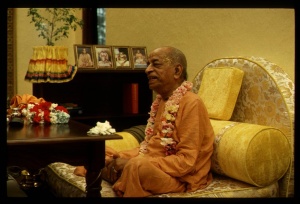CC Madhya 3.8

A.C. Bhaktivedanta Swami Prabhupada
TEXT 8
- parātma-niṣṭhā-mātra veṣa-dhāraṇa
- mukunda-sevāya haya saṁsāra-tāraṇa
SYNONYMS
para-ātma-niṣṭhā-mātra — only for the determination to serve Kṛṣṇa; veṣa-dhāraṇa — changing the dress; mukunda-sevāya — by serving Mukunda; haya — there is; saṁsāra-tāraṇa — liberation from this material bondage.
TRANSLATION
The real purpose of accepting sannyāsa is to dedicate oneself to the service of Mukunda. By serving Mukunda, one can actually be liberated from the bondage of material existence.
PURPORT
In this connection, Śrīla Bhaktivinoda Ṭhākura says that Śrī Caitanya Mahāprabhu accepted the sannyāsa order and recommended the determination of the Avantīpura bhikṣu to engage in the service of Mukunda. He accepted the brāhmaṇa’s version due to his determination to serve Mukunda. The sannyāsī dress is actually an attraction for material formality. Śrī Caitanya Mahāprabhu did not like such formality, but He wanted the essence of it—service to Mukunda. Such determination in any condition is parātma-niṣṭhā. That is required. The conclusion is that the sannyāsa order depends not on the dress but the determination to serve Mukunda.